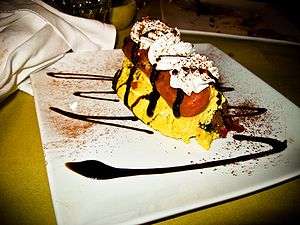Zuppa Inglese
 | |
| Course | Dessert |
|---|---|
| Place of origin | Italy |
| Region or state | Emilia-Romagna, Marche, Toscana, Lazio, Umbria |
| Main ingredients | Sponge cake or savoiardi, Alchermes, custard |
| Variations | Tiramisu |
|
| |
Zuppa Inglese (pronounced [ˈdzuppa iŋˈɡleːze; ˈtsuppa iŋˈɡleːse]; Italian for "English soup") is an Italian dessert layering custard and sponge cake, perhaps derived from trifle.
History
Recipes for this sweet first appeared in the towns of Parma, Bologna, Forlì, Ferrara, Florence and Reggio Emilia, all in the Emilia-Romagna or Tuscany regions, in the late nineteenth century. Its origins are uncertain and one theory states that it originated in the sixteenth century kitchens of the Dukes of Este, the rulers of Ferrara. They asked their cooks to recreate the sumptuous "English trifle" they had enjoyed in England at the Elizabethan court, where they were frequent visitors.
To make Zuppa Inglese, sponge cake or ladyfingers are dipped in Alchermes, a bright red, extremely aromatic Italian herb liqueur. They are then alternated with layers of crema pasticciera, a thick egg custard cooked with a large piece of lemon zest (removed afterwards). Often there is also a layer of crema alla cioccolata made by dissolving dark chocolate in a plain crema pasticciera. In Italy it is occasionally topped with cream, meringue or almonds.
Zuppa Inglese is usually homemade, but it can also be bought in pastry shops, and is a favourite cake for children's birthday parties. It is also a popular gelato flavour.
Name
The word "zuppa" in Italian cuisine refers to both sweet and savoury dishes. It comes from the verb "inzuppare" which means "to dunk". As the sponge cake or Lady fingers are dipped in liqueur the dish is called Zuppa. Similarly, thick fish, bean with vegetable stews, and fish or shellfish stews are properly described as "zuppa di verdure" or "zuppa di pesce". These savory dishes are served on toasted bread and eaten with knife and fork.
There are other theories as to the origin of the name.[1]
"The name translates literally in Italian as English soup and may in fact connote its similarity to English trifle. Others believe it is a dialectical corruption of the verb inzuppare, meaning to sop."[2]
"A dessert invented by Neapolitan pastrycooks of Europe during the 19th century. Inspired by English puddings that were fashionalbe [sic] at the time, . . . "[3]
"This rich dessert was among the many tributes bestowed on Lord Nelson by the grateful Neapolitans after his victory over Napoleon in the Nile in 1798. "English Soup", as it was called, was the creation of an anonymous pastry cook smitten with the admiral, the English, and their spirit-soaked Trifles."[4]
References
- ↑ "FAQs: charlotte to millet". Food Timeline. Retrieved June 8, 2015.
- ↑ Mariani, John. Dictionary of Italian Food and Drink. New York: Broadway Books, 1998 (p. 286)
- ↑ Larousse Gastronomique, Completely Updated and Revised. New York: Clarkson Potter, 2001 (p. 1310)
- ↑ American Heritage. The Horizon Cookbook and Illustrated History of Eating and Drinking through the Ages, New York: Doubleday, 1968 (p. 710)